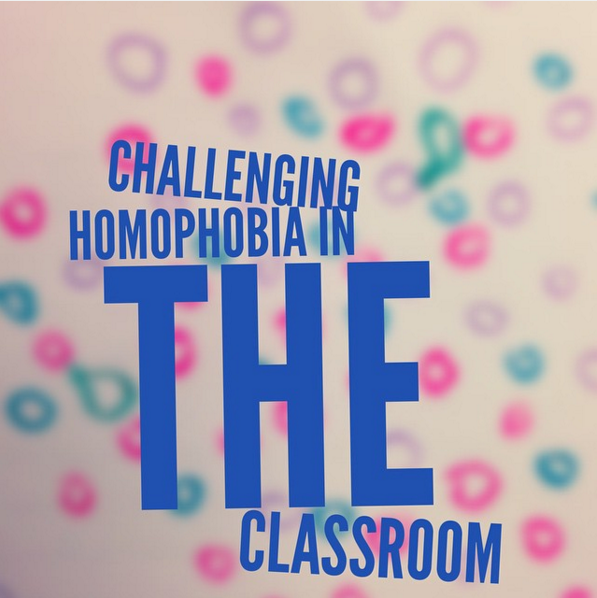
Challenging homophobia in the classroom
April 9, 2015
 You may have read recent news reports describing alarmingly high levels of homophobia in Australian teenage males. A study conducted by Beyond Blue revealed that the 14 to 17 year old boys surveyed were more homophobic than the general population. Approximately 40% revealed they did not feel comfortable around same sex attracted people, and 38% would not feel comfortable being friends with a same sex attracted person.
You may have read recent news reports describing alarmingly high levels of homophobia in Australian teenage males. A study conducted by Beyond Blue revealed that the 14 to 17 year old boys surveyed were more homophobic than the general population. Approximately 40% revealed they did not feel comfortable around same sex attracted people, and 38% would not feel comfortable being friends with a same sex attracted person.
The study also highlighted that homophobic bullying is common. 60% of the teenagers reported they had witnessed people being bullied because of their sexuality. In 2010, previous Australian research indicated that 80% of all homophobic bullying in young people takes place at school. These statistics have serious implications for the wellbeing of lesbian, gay, bisexual, transgender, intersex young people (LGBTI) in our schools, and highlights the need for more work to be done around bystander behaviour and homophobic bullying.
While the research focused on teenagers, this is not just an issue for secondary schools. Primary schools have an instrumental role to play in reducing homophobia. Primary schools generally work hard to establish a community culture of acceptance of individual difference, and appropriate social and behavioural norms. Promoting acceptance of individual differences whether they be race, religion, gender, income level, football team allegiance, intelligence, disability, hair colour or sexuality is crucial from an early age. In terms of normalising different relationships and sexuality, the need to do so is highlighted by the finding that at least half of all young people who are LGBTI realize they are same sex attracted while in primary school. Promoting anything but acceptance and support for all sexualities and gender identities can be detrimental to the wellbeing of these young people.
How can teachers help?
There is much that can be done to tackle homophobia at school. One of the simplest and most effective strategies is to immediately challenge any use of homophobic language. The Beyond Blue study found that approximately a quarter of those surveyed think it’s okay to say that something they don’t like is ‘gay’, and that terms such as ‘homo’ and ‘dyke’ are ‘not really that bad’.
School policies
Homophobic language should be explicitly addressed in the school’s anti-bullying or wellbeing policies, including procedures for dealing with complaints, and clear consequences for perpetrators.
When homophobic is language directed at the student
Homophobic verbal abuse directed at an individual should be addressed immediately and consistently. The Australian Research Centre in Sex, Health and Society recommends the three-step NAC approach:
- Name it. Name the problem, ‘You called James a faggot.’
- Agreement. Refer to the class rules/school policy: ‘Our class rules state that we do not use names/put-downs/no homophobic language.’
- Consequences. Give consequences: ‘As you know, this means you will have to…’ (Insert whatever the disciplinary procedure is at your school).
Before using the above approach your class/school must have established rules and procedures related to the use of homophobic language and all students and parents must be aware of these.
When homophobic language is not directed at a particular student
Some students (or staff members) may use words such as ‘gay’ or ‘homo’ to describe something as ‘bad’ or’ inferior’. For example, ‘This subject is so gay’. There is a misconception by many people that this type of word use is harmless. This is not the case. Although students may not mean to be homophobic, such use can have a negative impact on lesbian, gay, bisexual, transgender, intersex students and staff, and be perceived as homophobia.
Teachers can explore with their class the idea that allowing people to use the word ‘gay’ to mean something ‘inferior’ or ‘stupid’ sends a message that LGBTI are inferior. To illustrate this point you can insert an alternate word to ‘gay’ with other traits individuals are born with, such as ‘blue-eyed’, or ‘left-handed’. Beyond Blue’s Stop. Think. Respect. ad campaign may help with further thinking and discussion.
The three NAC step-approach above can also be used for indirect ‘…is so gay’ statements, and for repeated homophobic remarks. It can be also helpful to have a prepared one-liner to use when students use the word ‘gay’ as a one off. For example if a student says, ‘This video is so gay.’ You might say ‘Oh, is this video attracted to other videos?’ to point out the inappropriateness of the comment in a humorous way. For more one-liner ideas read the article Beyond ‘that’s so gay’.
More resources for schools and teachers:
Safe Schools Coalition – Challenging homophobia in schools: A guide for school staff.
Bully Stoppers (DE&T) – Challenging homophobic behaviour advice sheet.
Australian research centre in sex, health and society – Safety in our schools: Strategies for responding to homophobia.
Zoe Ganim, Psych4Schools Psychologist